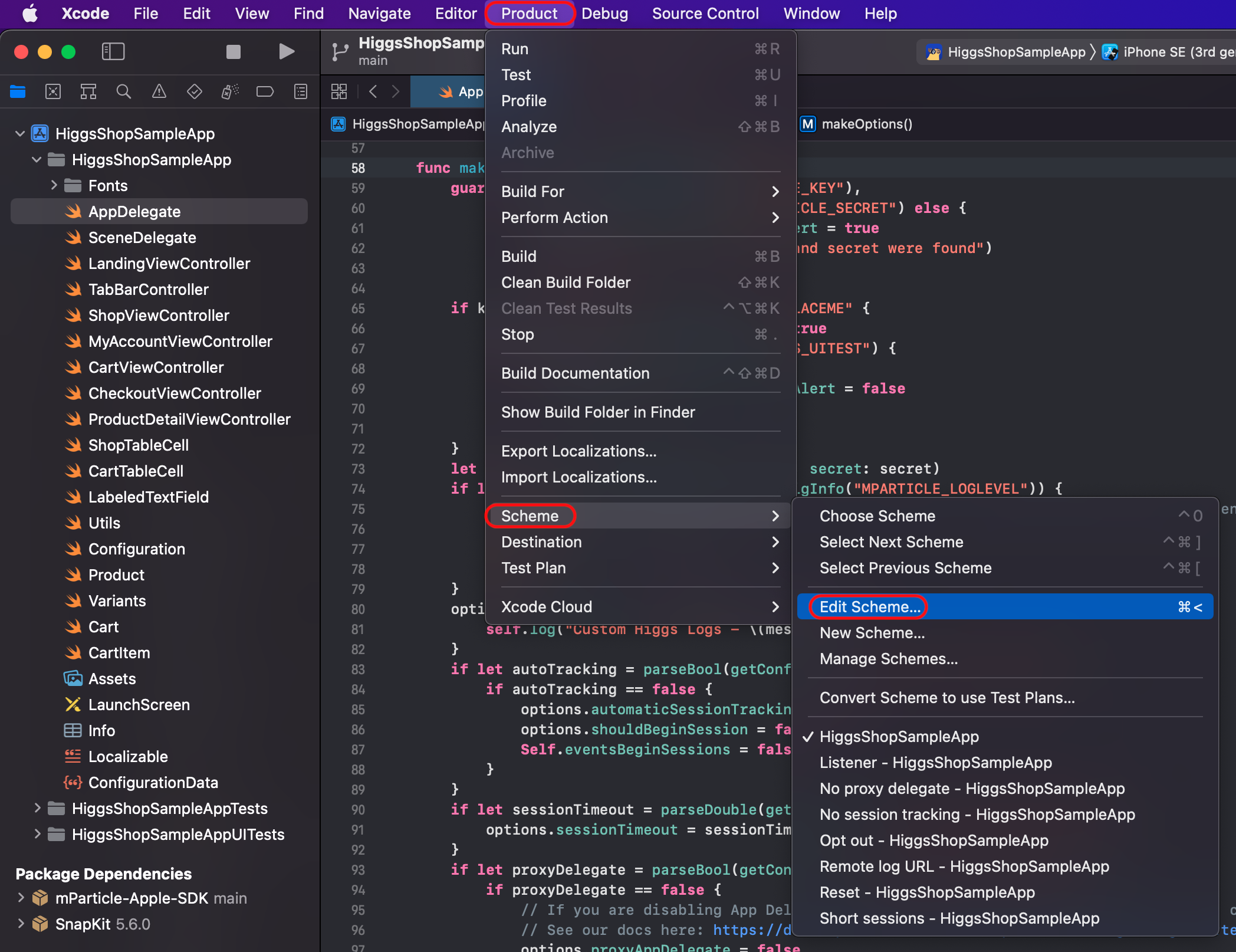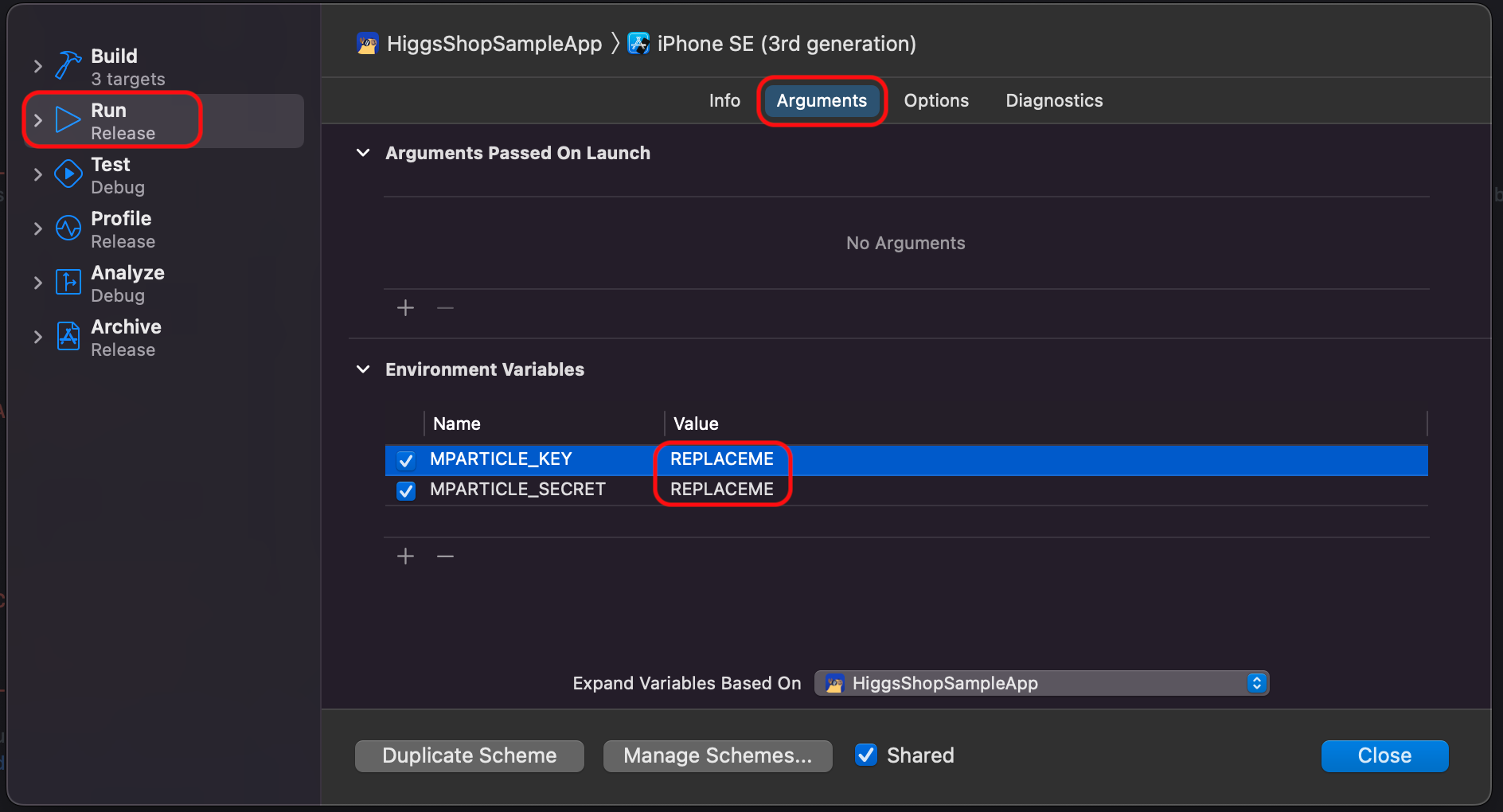Documentation
Developers
API References
Platform API
Platform API Overview
Accounts
Apps
Audiences
Calculated Attributes
Data Points
Feeds
Field Transformations
Services
Users
Workspaces
Data Subject Request API
Data Subject Request API Version 1 and 2
Data Subject Request API Version 3
Warehouse Sync API
Warehouse Sync API Overview
Warehouse Sync API Tutorial
Warehouse Sync API Reference
Data Mapping
Warehouse Sync SQL Reference
Warehouse Sync Troubleshooting Guide
ComposeID
Warehouse Sync API v2 Migration
Calculated Attributes Seeding API
Bulk Profile Deletion API Reference
Custom Access Roles API
Data Planning API
Group Identity API Reference
Pixel Service
Profile API
Events API
mParticle JSON Schema Reference
IDSync
Client SDKs
AMP
AMP SDK
Android
Initialization
Configuration
Network Security Configuration
Event Tracking
User Attributes
IDSync
Screen Events
Commerce Events
Location Tracking
Media
Kits
Application State and Session Management
Data Privacy Controls
Error Tracking
Opt Out
Push Notifications
WebView Integration
Logger
Preventing Blocked HTTP Traffic with CNAME
Linting Data Plans
Troubleshooting the Android SDK
API Reference
Upgrade to Version 5
Cordova
Cordova Plugin
Identity
Direct Url Routing
Direct URL Routing FAQ
Web
Android
iOS
iOS
Initialization
Configuration
Event Tracking
User Attributes
IDSync
Screen Tracking
Commerce Events
Location Tracking
Media
Kits
Application State and Session Management
Data Privacy Controls
Error Tracking
Opt Out
Push Notifications
Webview Integration
Upload Frequency
App Extensions
Preventing Blocked HTTP Traffic with CNAME
Linting Data Plans
Troubleshooting iOS SDK
Social Networks
iOS 14 Guide
iOS 15 FAQ
iOS 16 FAQ
iOS 17 FAQ
iOS 18 FAQ
API Reference
Upgrade to Version 7
React Native
Getting Started
Identity
Unity
Upload Frequency
Getting Started
Opt Out
Initialize the SDK
Event Tracking
Commerce Tracking
Error Tracking
Screen Tracking
Identity
Location Tracking
Session Management
Web
Initialization
Configuration
Content Security Policy
Event Tracking
User Attributes
IDSync
Page View Tracking
Commerce Events
Location Tracking
Media
Kits
Application State and Session Management
Data Privacy Controls
Error Tracking
Opt Out
Custom Logger
Persistence
Native Web Views
Self-Hosting
Multiple Instances
Web SDK via Google Tag Manager
Preventing Blocked HTTP Traffic with CNAME
Facebook Instant Articles
Troubleshooting the Web SDK
Browser Compatibility
Linting Data Plans
API Reference
Upgrade to Version 2 of the SDK
Xamarin
Getting Started
Identity
Web
Alexa
Server SDKs
Node SDK
Go SDK
Python SDK
Ruby SDK
Java SDK
Quickstart
Android
Overview
Step 1. Create an input
Step 2. Verify your input
Step 3. Set up your output
Step 4. Create a connection
Step 5. Verify your connection
Step 6. Track events
Step 7. Track user data
Step 8. Create a data plan
Step 9. Test your local app
iOS Quick Start
Overview
Step 1. Create an input
Step 2. Verify your input
Step 3. Set up your output
Step 4. Create a connection
Step 5. Verify your connection
Step 6. Track events
Step 7. Track user data
Step 8. Create a data plan
Python Quick Start
Step 1. Create an input
Step 2. Create an output
Step 3. Verify output
Guides
Partners
Introduction
Outbound Integrations
Outbound Integrations
Firehose Java SDK
Inbound Integrations
Compose ID
Data Hosting Locations
Glossary
Migrate from Segment to mParticle
Migrate from Segment to mParticle
Migrate from Segment to Client-side mParticle
Migrate from Segment to Server-side mParticle
Segment-to-mParticle Migration Reference
Rules Developer Guide
API Credential Management
The Developer's Guided Journey to mParticle
Guides
Getting Started
Create an Input
Start capturing data
Connect an Event Output
Create an Audience
Connect an Audience Output
Transform and Enhance Your Data
Personalization
Introduction
Profiles
Audiences
Audiences Overview
Create an Audience
Connect an Audience
Manage Audiences
Real-time Audiences (Legacy)
Standard Audiences (Legacy)
Calculated Attributes
Calculated Attributes Overview
Using Calculated Attributes
Create with AI Assistance
Calculated Attributes Reference
Predictive Audiences
Predictive Audiences Overview
Using Predictive Audiences
Journeys
Journeys Overview
Manage Journeys
Download an audience from a journey
Audience A/B testing from a journey
Journeys 2.0
Predictive Attributes
What are predictive attributes?
Platform Guide
Billing
Usage and Billing Report
The New mParticle Experience
The new mParticle Experience
The Overview Map
Observability
Observability Overview
Observability User Guide
Observability Troubleshooting Examples
Observability Span Glossary
Introduction
Data Retention
Connections
Activity
Live Stream
Data Filter
Rules
Tiered Events
mParticle Users and Roles
Analytics Free Trial
Troubleshooting mParticle
Usage metering for value-based pricing (VBP)
Analytics
Introduction
Setup
Sync and Activate Analytics User Segments in mParticle
User Segment Activation
Welcome Page Announcements
Settings
Project Settings
Roles and Teammates
Organization Settings
Global Project Filters
Portfolio Analytics
Analytics Data Manager
Analytics Data Manager Overview
Events
Event Properties
User Properties
Revenue Mapping
Export Data
UTM Guide
Query Builder
Data Dictionary
Query Builder Overview
Modify Filters With And/Or Clauses
Query-time Sampling
Query Notes
Filter Where Clauses
Event vs. User Properties
Group By Clauses
Annotations
Cross-tool Compatibility
Apply All for Filter Where Clauses
Date Range and Time Settings Overview
User Attributes at Event Time
Understanding the Screen View Event
Analyses
Analyses Introduction
Segmentation: Basics
Getting Started
Visualization Options
For Clauses
Date Range and Time Settings
Calculator
Numerical Settings
Segmentation: Advanced
Assisted Analysis
Properties Explorer
Frequency in Segmentation
Trends in Segmentation
Did [not] Perform Clauses
Cumulative vs. Non-Cumulative Analysis in Segmentation
Total Count of vs. Users Who Performed
Save Your Segmentation Analysis
Export Results in Segmentation
Explore Users from Segmentation
Funnels: Basics
Getting Started with Funnels
Group By Settings
Conversion Window
Tracking Properties
Date Range and Time Settings
Visualization Options
Interpreting a Funnel Analysis
Funnels: Advanced
Group By
Filters
Conversion over Time
Conversion Order
Trends
Funnel Direction
Multi-path Funnels
Analyze as Cohort from Funnel
Save a Funnel Analysis
Explore Users from a Funnel
Export Results from a Funnel
Saved Analyses
Manage Analyses in Dashboards
Dashboards
Dashboards––Getting Started
Manage Dashboards
Dashboard Filters
Organize Dashboards
Scheduled Reports
Favorites
Time and Interval Settings in Dashboards
Query Notes in Dashboards
User Aliasing
Analytics Resources
The Demo Environment
Keyboard Shortcuts
Tutorials
Analytics for Marketers
Analytics for Product Managers
Compare Conversion Across Acquisition Sources
Analyze Product Feature Usage
Identify Points of User Friction
Time-based Subscription Analysis
Dashboard Tips and Tricks
Understand Product Stickiness
Optimize User Flow with A/B Testing
User Segments
IDSync
IDSync Overview
Use Cases for IDSync
Components of IDSync
Store and Organize User Data
Identify Users
Default IDSync Configuration
Profile Conversion Strategy
Profile Link Strategy
Profile Isolation Strategy
Best Match Strategy
Aliasing
Data Master
Group Identity
Overview
Create and Manage Group Definitions
Introduction
Catalog
Live Stream
Data Plans
Data Plans
Blocked Data Backfill Guide
Warehouse Sync
Data Privacy Controls
Data Subject Requests
Default Service Limits
Feeds
Cross-Account Audience Sharing
Approved Sub-Processors
Import Data with CSV Files
Import Data with CSV Files
CSV File Reference
Glossary
Video Index
Analytics (Deprecated)
Identity Providers
Single Sign-On (SSO)
Setup Examples
Introduction
Developer Docs
Introduction
Integrations
Introduction
Rudderstack
Google Tag Manager
Segment
Data Warehouses and Data Lakes
Advanced Data Warehouse Settings
AWS Kinesis (Snowplow)
AWS Redshift (Define Your Own Schema)
AWS S3 Integration (Define Your Own Schema)
AWS S3 (Snowplow Schema)
BigQuery (Snowplow Schema)
BigQuery Firebase Schema
BigQuery (Define Your Own Schema)
GCP BigQuery Export
Snowflake (Snowplow Schema)
Snowplow Schema Overview
Snowflake (Define Your Own Schema)
Developer Basics
Aliasing
Step 1. Create an input
An input is the original source of the data you want to track. This could be a website, mobile app, or even a data feed from another platform. The mParticle SDK you use depends on your input.
In this tutorial, we’ll use the iOS SDK. However, before we can fully integrate the SDK into our app we need to create the input in our mParticle account.
1.1 Create an input
- Navigate to https://app.mparticle.com/ and log in. Depending on your location, you might need to log into mParticle via a specific pod URL. For a full list of these URLs view Data Hosting Locations.
- In the left nav bar, click Setup, then click Inputs. You’ll see a list of supported platforms.
- Select iOS.

- Click Issue Keys.
- Copy your new key and secret before clicking Close.
1.2 Initialize the SDK
The iOS SDK is initialized in an MParticleOptions object. When initializing the SDK, you must include both your API key and secret generated when setting up an iOS input in mParticle.
The Higgs Shop initializes the SDK in the file core-sdk-samples/higgs-shop-sample-app/HiggsShopSampleApp/AppDelegate.swift:
func makeOptions() -> MParticleOptions? {
guard let key = getConfigInfo("MPARTICLE_KEY"),
let secret = getConfigInfo("MPARTICLE_SECRET") else {
AppDelegate.shouldShowCredsAlert = true
log("Error: No mParticle key and secret were found")
return nil
}
if key == "REPLACEME" || secret == "REPLACEME" {
AppDelegate.shouldShowCredsAlert = true
if let value = getOverrideConfig("IS_UITEST") {
if value == "YES" {
AppDelegate.shouldShowCredsAlert = false
}
}
}
let options = MParticleOptions(key: key, secret: secret)
if let logLevel = parseLogLevel(getConfigInfo("MPARTICLE_LOGLEVEL")) {
// Log level is set to .none by default--you should use a preprocessor directive to ensure it is only set for your non-App Store build configurations (e.g. Debug, Enterprise distribution, etc)
#if DEBUG
options.logLevel = logLevel
#endif
}
options.customLogger = { (message: String) in
self.log("Custom Higgs Logs - \(message)")
}
if let autoTracking = parseBool(getConfigInfo("MPARTICLE_AUTOTRACKING")) {
if autoTracking == false {
options.automaticSessionTracking = false
options.shouldBeginSession = false
Self.eventsBeginSessions = false
}
}
if let sessionTimeout = parseDouble(getConfigInfo("MPARTICLE_SESSIONTIMEOUT")) {
options.sessionTimeout = sessionTimeout
}
if let proxyDelegate = parseBool(getConfigInfo("MPARTICLE_PROXYDELEGATE")) {
if proxyDelegate == false {
// If you are disabling App Delegate proxying, you will need to manually forward certain App Delegate methods.
// See our docs here: https://docs.mparticle.com/developers/client-sdks/ios/configuration/#uiapplication-delegate-proxy
options.proxyAppDelegate = false
}
}
return options
}Notice that when the Higgs Shop sample app initializez the SDK, some options (like the log level, key, and secret) are defined in environment variables which can be changed by editing the scheme in Xcode.
1.3 Insert your API key and secret
The Higgs Shop sample app defines environment variables for your API key and secret in a scheme. To add your API key and secret to the sample app:
- Open
HiggsShopSampleApp.xcodeprojin Xcode. - From your computer’s menu bar, click Product > Scheme > Edit Scheme….

- Make sure Run is selected in the left nav bar of the modal. Click Arguments.
- Under Environment Variables replace the text
REPLACEMEwith your API key and secret for the variables namedMPARTICLE_KEYandMPARTICLE_SECRET.

- Click Close.
1.4 iOS SDK configuration settings
The SDK includes configuration settings so you can customize your integration. There are two that you should be aware of at this stage:
Environment
Data sent from your app to mParticle is labeled as either Development or Production. By default, the sample app is configured to label all data as Development. Since you are setting up a development environment to learn how the iOS SDK works, do not change this setting.
If you were to release an iOS app to the public with an mParticle integration, you can change the environment to Production by editing the scheme:
- Select Product > Scheme > Edit Scheme… in the menu bar.
- With Run selected in the left nav bar of the modal, click Info.
- In the Build Configuration dropdown, select Release. Click Close.
Log level
You can set your log level to VERBOSE or ERROR depending on the level of detail you want printed to the console when running your app. By default, the sample app is configured with the VERBOSE log level. Do not change this setting when following this tutorial.
Learn more about iOS SDK log level settings in Getting Started.
Was this page helpful?
- Last Updated: February 27, 2025